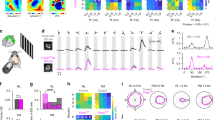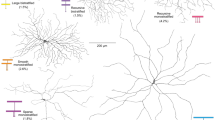Abstract
Direction-selective neurons exist at different levels of the visual system in different vertebrates and invertebrates. In accordance with the name, such cells respond differently (asymmetrically) to different moving stimuli, depending on their direction. Contrast borders, stripes, spots which move in preferred direction cause a strong impulse discharge of the neuron, but the same stimuli moving in opposite direction (“0”-direction) do not cause response. Thus, these neurons are capable of recognition of the direction of stimulus movement. It is possible to use this in different forms of visual-based behavior.
Similar content being viewed by others
References
Barlow, H.B., Hill, R.M, and Levick, W.R., Retinal ganglion cells responding selectively to direction and speed of image motion in the rabbit, J. Physiol., 1964, vol. 173, pp. 377–407.
Barlow, H.B. and Levick, W.R., The mechanism of directionally selective units in rabbit’s retina, J. Physiol., 1965, vol. 178, pp. 477–504.
Briggman, K.L., Helmstaedter, M., and Denk, W., Wiring specificity in the direction-selectivity circuit of the retina, Nature, 2011, vol. 471, pp. 183–188.
Borst, A. and Euler, T., Seeing things in motion: Models, circuits, and mechanisms, Neuron, 2011, vol. 71, no. 6, pp. 974–994.
Chen, Y.-C. and Chiao, C.-C., Symmetrical synaptic patterns between starburst amacrine cells and direction selective ganglion cells in the rabbit retina, J. Compar. Neurol., 2008, vol. 508, pp. 175–183.
Chen, M., Weng, S., Deng, Q., et al., Physiological properties of direction-selective ganglion cells in early postnatal and adult mouse retina, J. Physiol., 2009, vol. 587, no. 4, pp. 819–828.
Coombs J.L., Van Der List, D., and Chapula, L.M., Morphological properties of mouse retinal ganglion cells during postnatal development, J. Compar. Neurol., 2007, vol. 503, pp. 803–814.
Damjanovic-, I., Maximova, E.M., and Maximov, V.V., Receptive field sizes of direction-selective units in the fish tectum, J. Integr. Neurosci., 2009. vol. 8, no. 1, pp. 77–93.
Dong, W., Sun, W., Zhang, Y., et al., Dendritic relationship between starburst amacrine cells and direction selective ganglion cells in the rabbit retina, J. Physiol., 2004, vol. 556, pp. 11–17.
Elstrott, J., Anishchenko, A., Greschner, M., et al., Direction selectivity in the retina is established independent of visual experience and cholinergic retinal waves, Neuron, 2008, vol. 58, no. 4, pp. 499–506.
Euler, T., Detwiler, P.B., and Denk, W., Directionally selective calcium signals in dendrites of starburst amacrine cells, Nature, 2002, vol. 418, pp. 845–852.
Famiglietti, E.V., Dendritic co-stratification of ON and ON-OFF directionally selective ganglion cells with starburst amacrine cells in rabbit retina, J. Compar. Neurol., 1992, vol. 324, pp. 322–335.
Fried, S.I., Münch, T.A., and Werblin, F.S., Mechanisms and circuitry underlying directional selectivity in the retina, Nature, 2002, vol. 420, pp. 411–414.
Fuerst, P.G., Koizumi, A., Masland, R.H., and Burgess, R.W., Neurite arborization and mosaic spacing in the mouse retina require DSCAM, Nature, 2008, vol. 451, pp. 470–474.
Gabriel, J.P., Trivedi, C.A., Maurer, C.M., et al., Layerspecific targeting of direction-selective neurons in the zebrafish optic tectum, Neuron, 2012, vol. 76, pp. 1147–1160.
Giolli, R.A, Blanks, R.H.I., and Lui, F., The accessory optic system: Basic organization with an update on connectivity, neurochemistry, and function, Progr. Brain Res., 2005, vol. 151, pp. 407–440.
Grama, A. and Engert, F., Direction selectivity in the larval zebrafish tectum is mediated by asymmetrical inhibition, Front. Neural Circuits, September 2012, vol. 6, art. 59, pp. 1–4 [www.frontiersin.org].
He, S. and Masland, R.H., On direction-selective ganglion cells in the rabbit retina: Dendritic morphology and pattern of fasciculation, Vis. Neurosci., 1998, vol. 15, pp. 369–375.
He, S., Jin, Z.F., and Masland, R.H., The nondiscriminating zone of directionally selective retinal ganglion cells: Comparison with dendritic structure and implications for mechanism, J. Neurosci., 1999, vol. 19, pp. 8049–8056.
Jacobson, M. and Gaze, R.M., Types of visual response from single units in the optic tectum and optic nerve of the goldfish, Q. J. Exp. Physiol., 1964, vol. 49, pp. 199–209.
Kay, J.N., De la Huerta, I., Kim, I.-J., et al., Retinal ganglion cells with distinct directional preferences differ in molecular identity, structure, and central projections, J. Neurosci., 2011, vol. 31, no. 21, pp. 7753–7762.
Kim, I.-J., Zhang, Y., Yamagata, M., et al., Molecular identification of a retinal cell type that responds to upward motion, Nature, 2008, vol. 452, pp. 478–482.
Kittila, C.A. and Massey, S.C., Pharmacology of directionally selective ganglion cells in the rabbit retina, J. Neurophysiol., 1997, vol. 77, pp. 675–689.
Kong, J.H., Fish, D.R., Rockhill, R.L., and Masland, R.H., Diversity of ganglion cells in the mouse retina: Unsupervised morphological classification and its limits, J. Compar. Neurol., 2005, vol. 489, no. 3, pp. 293–310.
Lee, S., Kim, K., and Zhou, Z.J., Role of ACh-GABA cotransmission in detecting image motion and motion direction, J. Neuron., 2010, vol. 68, no. 6, pp. 1159–1172.
Masland, R.H., The fundamental plan of the retina, Nature, 2001, vol. 4, pp. 877–886.
Masland, R.H., The neuronal organization of the retina, Neuron, 2012, vol. 76, no. 2, pp. 266–80.
Masland, R.H., Mills, J.W., and Hayden, S.A., Acetylcholine-synthesizing amacrine cells: Identification and selective staining by using radioautography and fluorescent markers, Proc. Roy. Soc. London B, 1984, vol. 223, pp. 79–100.
Marc, R.E., Neurochemical stratification in the inner plexiform layer of the vertebrate retina, Vis. Res., 1986, vol. 26, pp. 223–238.
Marc, R.E. and Jones, B.W., Molecular phenotyping of retinal ganglion cells, J. Neurosci., 2002, vol. 22, no. 2, pp. 413–427.
Maturana, H.R. and Frenk, S., Directional movement and horizontal edge detectors in the pigeon retina, Science, 1963, vol. 142, pp. 977–979.
Maximov, V.V., Maximova, E.M., and Maximov, P.V., Classification of direction-selective elements recorded in the tectum of crucian, Sens. Sist., 2005a, vol. 19, no. 4, pp. 342–356.
Maximov, V., Maximova, E., and Maximov, P., Direction selectivity in the goldfish tectum revisited, Ann. New York Acad. Sci., 2005b, vol. 1048, pp. 198–205.
Maximov, V.V., Maximova, E.M., and Maximov, P.V., Color characteristics of detectors of movement direction projecting in the crucian tectum, Sens. Sist., 2007, vol. 21, no. 1, pp. 19–28.
Maximova, E.M., Neurotransmitters of the retina and reorganizations in the nerve layers of the retina at degeneration of photoreceptors: Review, Sens. Sist., 2008, vol. 22, no. 1, pp. 36–51.
Maximova, E.M., Molecular identification of retina neurons Sens. Sist., 2009, vol. 23, no. 4, pp. 283–292.
Maximova, E.M., Levichkina, E.V., and Utina, I.A., Morphology of presumable direction-selective ganglion cells, traced DiI in fish retina, Sens. Sist., 2006, vol. 20, no. 4, pp. 279–287.
Maximova, E., Pushchin, I., Maximov, P., and Maximov, V., Presynaptic and postsynaptic visual responses in the goldfish rectum as revealed by calcium channel blocker, JIN, 2010, vol. 11, no. 2, pp. 183–191.
Nikolaou, N., Lowe, A.S., Walker, A.S., et al., Parametric functional maps of visual inputs to the tectum, Neuron, 2012, vol. 76, pp. 317–324.
Portugues, R. and Engert, F., The neural basis of visual behaviors in the larval zebrafish, Front. Neural. Circuits, 2012, vol. 6, art. 59, pp. 1–9.
Rivlin-Etzion, M., Zhou, K., Wei, W., et al., Transgenic mice reveal unexpected diversity of ON-OFF direction-selective retinal ganglion cell subtypes and brain structures involved in motion processing, J. Neurosci., 2011, vol. 31, no. 24, pp. 8760–8769.
Rockhill, R.L., Daly, F.J., MacNeil, M.A., et al., The diversity of ganglion cells in a mammalian retina, J. Neurosci., 2002, vol. 22, pp. 3831–3843.
Roska, B. and Werblin, F., Vertical interactions across ten parallel, stacked representations in the mammalian retina, Nature, 2001, vol. 410, pp. 583–587.
Stacy, R.C. and Wong, R.O.L., Developmental relationship between cholinergic amacrine cell processes and ganglion cell dendrites of the mouse retina, J. Compar. Neurol., 2003, vol. 456, pp. 154–166.
Sun, W., Deng, Q., Levick, W.R., and He, S., On direction-selective ganglion cells in the mouse retina, J. Physiol., 2006, vol. 576, no. 1, pp. 197–202.
Sun, L., Han, X., and He, S., Direction-selective circuitry in rat retina develops independently of GABAergic, cholinergic and action potential activity, PLoS, 2011, vol. 6, no. 5, e19477, pp. 1–10.
Tsvilling, V., Donchin, O., Shamir, M., and Segev, R., Archer fish fast hunting maneuver may be guided by directionally selective retinal ganglion cells, Europ. J. Neurosci., 2012, vol. 35, pp. 436–444.
Uchiyama, H., Kanaya, T., and Sonohata, S., Computation of motion direction by quail retinal ganglion cells that have a nonconcentric receptive field, Vis. Neurosci., 2000, vol. 17, no. 2, pp. 263–271.
Vaney, D.I., Territorial organization of direction-selective ganglion cells in rabbit retina, J. Neurosci., 1994, vol. 14, pp. 6301–6316.
Weng, S., Sun, W., and He, S., Identification of ON-OFF direction-selective ganglion cells in the mouse retina, J. Physiol., 2005, vol. 562, no. 3, pp. 915–923.
Yamagata, M. and Sanes, J.R., Dscam and Sidekick proteins direct lamina-specific synaptic connections in vertebrate retina, Nature, 2008, vol. 451, pp. 465–469.
Yamagata, M., Sanes, J. R., Weiner, A., et al., Labeled lines in the retinotectal system: Markers for retinorecipient sublaminae and the retinal ganglion cell subsets that innervate them, Mol. Cell. Neurosci., 2006, vol. 33, pp. 296–310.
Yonehara, K., Ishikane, H., Sakuta, H., et al., Identification of retinal ganglion cells and their projections involved in central transmission of information about upward and downward image motion, PLoS ONE, 2009, vol. 4, pp. e4420.
Yonehara, K., Shintani, T., Suzuki, R., et al., Expression of SPIG1 reveals development of a retinal ganglion cell subtype projecting to the medial terminal nucleus in the mouse, PLoS ONE, 2008, vol. 3, pp. e1533.
Yoshida, K., Watanabe, D., Ishikane, H., et al., A key role of starburst amacrine cells in originating retinal directional selectivity and optokinetic eye movement, Neuron, 2001, vol. 30, pp. 771–780.
Zenkin, G.M. and Pigarev, I.N., Detector characteristics of ganglion cells in the retina of pike, Biofizika, 1969, vol. 14, pp. 722–730.
Author information
Authors and Affiliations
Corresponding author
Rights and permissions
About this article
Cite this article
Maximova, E.M. Functional asymmetry of a particular type of retinal neurons in apparent symmetry of its morphology. Paleontol. J. 48, 1303–1308 (2014). https://doi.org/10.1134/S0031030114120065
Received:
Published:
Issue Date:
DOI: https://doi.org/10.1134/S0031030114120065




